AI vs. Human Intuition: Why Smart Hiring Combines Both
The hiring world is buzzing about AI, but the real question isn't whether AI or human judgment is better—it's how to combine both for smarter hiring decisions that you can trust and defend.
Maria, a startup founder, was skeptical when her team suggested using AI for hiring. "I've always hired based on gut feeling," she said. "How can a computer understand if someone will fit with our team culture?"
Six months later, after using AI-powered candidate analysis alongside her intuitive evaluation process, Maria had hired her strongest team ever. "The AI doesn't replace my judgment," she explains. "It makes sure I don't miss anything important and gives me confidence in my decisions."
This is the reality of modern hiring: it's not AI versus human intuition - it's AI enhancing human decision-making. Let's explore why the most successful hiring managers are learning to combine both approaches.

The Case for AI in Hiring
What AI Excels At
Pattern Recognition: AI can quickly identify patterns across hundreds of resumes that would take humans hours to spot. It notices when candidates with specific combinations of skills or experience tend to succeed in similar roles.
Consistency: Unlike humans, AI doesn't have bad days, doesn't get tired after reviewing 50 applications, and doesn't unconsciously favor candidates who remind it of successful past hires. It applies the same criteria consistently to every candidate.
Information Processing: Modern AI can analyze not just what's on a resume, but also public information like portfolios, GitHub contributions, published work, and professional achievements that candidates might not have mentioned.
Bias Reduction: When properly trained, AI can help reduce unconscious bias by focusing on qualifications and performance indicators rather than factors like name, school, or gaps in employment that might unconsciously influence human reviewers.
Real-World AI Success Stories
The Engineering Manager's Discovery: Tom, an engineering manager at a growing SaaS company, was hiring for a senior developer role. His AI analysis flagged a candidate whose resume looked light on experience, but whose GitHub showed extensive contributions to open-source projects highly relevant to their tech stack. "I would have passed on this candidate based on years of experience alone," Tom admits. "But the AI showed me the depth of their actual work, and they turned out to be our strongest hire."
The Marketing Director's Time Savings: Lisa used to spend 10-15 minutes reviewing each marketing candidate's portfolio and background. With AI pre-analysis, she now spends 3-4 minutes per candidate while getting deeper insights. "The AI does the initial research I used to do manually—finding their blog posts, social media presence, case studies they've written. I can focus on evaluating their strategic thinking instead of hunting for information."
The Case for Human Intuition
What Humans Excel At
Cultural Fit Assessment: No AI can truly understand your team's specific dynamics, communication style, or company culture. Humans excel at reading between the lines and sensing whether someone will thrive in your specific environment.
Motivation and Drive: While AI can analyze what someone has done, humans are better at understanding why they did it and what drives them. The hunger to learn, passion for the mission, and resilience in face of challenges are human qualities that require human evaluation.
Communication and Collaboration: AI can identify that someone has worked on team projects, but only humans can assess how effectively someone explains complex ideas, handles disagreement, or builds consensus.
Potential Over Pedigree: Experienced managers often excel at spotting diamond-in-the-rough candidates—people who may not have perfect backgrounds but show exceptional potential, creativity, or hunger that will lead to outsized contributions.
The Irreplaceable Human Elements
Contextual Decision Making: Every hiring decision exists within context—your current team composition, upcoming projects, company stage, budget constraints. Humans excel at weighing these complex, interconnected factors that change with every hire.
Ethical Considerations: Hiring decisions affect people's lives and careers. The ethical dimension of these choices—fairness, giving someone a chance, considering unique circumstances—requires human judgment and values.
Strategic Thinking: Is this person capable of growing with the role? Can they adapt as the company evolves? Will they become a leader? These forward-looking assessments require human strategic thinking.
Where Each Approach Falls Short
AI Limitations in Hiring
The Algorithm Trap: AI models are only as good as their training data. If they're trained on past hiring decisions, they might perpetuate historical biases or favor certain types of candidates that worked in different contexts.
Context Blindness: AI might flag a candidate as "overqualified" without understanding that they're genuinely excited about a smaller company environment or career change opportunity.
Innovation Penalty: AI tends to favor candidates who look like past successful hires, potentially missing innovative thinkers or people with non-traditional backgrounds who could bring fresh perspectives.
The Correlation vs. Causation Problem: AI might identify patterns that are correlative rather than causative. Just because successful engineers at your company tend to have Computer Science degrees doesn't mean the degree caused their success.
Human Bias and Limitations
Unconscious Bias: Despite best intentions, humans make biased decisions based on factors like similarity to themselves, first impressions, or irrelevant characteristics.
Information Overload: When reviewing many candidates, humans get fatigued and start making faster, less careful decisions. Quality of evaluation decreases with volume.
Recency Effect: Humans tend to remember recent candidates more vividly than earlier ones, leading to unfair comparisons.
Confirmation Bias: Once humans form an initial impression of a candidate, they tend to look for information that confirms that impression rather than objectively evaluating all evidence.
The Winning Combination: AI + Human Judgment
The Complementary Approach
The most effective hiring processes use AI and human judgment for what each does best:
AI for Initial Processing:
- Screen applications for basic qualifications
- Identify relevant experience and skills
- Surface additional information about candidates
- Flag potential concerns or mismatches
- Organize and prioritize candidates for human review
Humans for Final Decisions:
- Assess cultural fit and team chemistry
- Evaluate communication and collaboration skills
- Make contextual decisions based on current needs
- Spot unique potential or unconventional strengths
- Consider ethical and strategic factors
A Practical Framework
Step 1: AI-Powered Initial Review
Let AI analyze all applications for basic qualifications, relevant experience, and potential fit indicators. This helps you avoid missing qualified candidates and ensures consistent initial evaluation.
Step 2: Human Strategic Filtering
Review AI insights and apply your knowledge of current team needs, company culture, and strategic priorities to create your interview shortlist.
Step 3: Human-Led Interviews
Use interviews to assess what AI can't: communication skills, cultural fit, motivation, and how they think through problems.
Step 4: Combined Final Decision
Synthesize AI insights about qualifications and experience with your human assessment of fit and potential to make the final hiring decision.
Real-World Implementation
Case Study: GrowthCo's Hybrid Approach
GrowthCo, a 25-person marketing agency, implemented a hybrid AI + human hiring process:
Before: Founder spent 2-3 hours per week reviewing applications manually, often missing qualified candidates buried in email, and making inconsistent decisions based on whatever stood out most recently.
After: AI pre-processes applications, identifies key qualifications, and surfaces relevant portfolio work. Founder now spends 45 minutes per week on initial review but makes better-informed decisions.
Results:
- 50% reduction in time spent on initial application review
- 30% increase in qualified candidates making it to interviews
- Zero bad hires in 12 months (compared to 2 in the previous year)
- Improved diversity in candidate pool due to reduced unconscious bias
Common Implementation Mistakes to Avoid
Over-Reliance on AI Scores: Don't just hire whoever gets the highest AI match score. Use the analysis as input, not a final decision.
Ignoring AI Insights: Some managers dismiss AI recommendations without consideration. If AI consistently flags concerns you're ignoring, at least understand why.
Not Training Your Team: Make sure everyone involved in hiring understands what the AI is analyzing and how to interpret its insights.
Forgetting the Human Element: AI can help you identify qualified candidates, but you still need to determine if they're the right fit for your specific situation.
The Future of AI-Human Collaboration in Hiring
Emerging Trends
Predictive Analytics: AI will get better at predicting not just who can do the job, but who will stay, grow, and contribute long-term value.
Bias Detection: Advanced AI will help identify when human decision-makers are showing bias patterns and suggest more objective evaluation approaches.
Skills-Based Matching: AI will become more sophisticated at identifying transferable skills and non-traditional paths to success.
Candidate Experience: AI will help personalize the hiring experience for candidates while providing humans with better insights about candidate preferences and motivations.
What This Means for Hiring Managers
The hiring managers who will be most successful are those who learn to effectively combine AI insights with human judgment. This means:
- Stay curious about AI capabilities while maintaining confidence in human decision-making
- Use AI to handle routine analysis so you can focus on strategic and interpersonal evaluation
- Develop better frameworks for the uniquely human aspects of hiring assessment
- Continuously refine how you integrate AI insights with your decision-making process
Practical Steps to Get Started
If you're ready to combine AI and human judgment in your hiring:
- Start with organization. Before adding AI, make sure you have a consistent process for collecting and reviewing applications.
- Identify your pain points. Where do you struggle most? Missing qualified candidates? Taking too long to review applications? Inconsistent evaluation criteria?
- Try AI for initial screening. Use AI to help with the parts of hiring that are most time-consuming or prone to oversight.
- Maintain human control. Always make final decisions based on human judgment informed by AI insights, not replaced by them.
- Track your results. Monitor whether the combination of AI + human judgment leads to better hiring outcomes over time.
The Bottom Line
The future of hiring isn't AI replacing human judgment—it's AI augmenting human decision-making. The most successful hiring managers will be those who learn to leverage AI's strengths in pattern recognition and information processing while maintaining human control over the strategic, cultural, and ethical dimensions of hiring decisions.
As Maria learned, AI doesn't eliminate the need for human intuition in hiring. Instead, it provides the information and analysis that makes human intuition more accurate, consistent, and defensible.
The question isn't whether to use AI or trust human judgment in hiring. The question is how to combine both effectively to make the best possible decisions for your team and your business.
Ready to experience the power of AI-enhanced hiring? The key is finding tools that augment your decision-making without taking control away from you. Start with simple AI insights that help you organize applications and surface key information, then build confidence in combining AI analysis with your human judgment.











